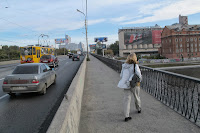 |
| Dawn in Yekatrinburg the Cathedral of the Blood in the center |
We walked north over a wide
transit and vehicular bridge leaving the new government and industrial center
and over to the older cultural and religious center. Ekaterinburg is a young city with young
couples, young singles and young families everywhere, dotted with the occasional lumbering old
large woman in a babushka and older men leaning on railings at bus stops smoking.
.JPG) |
| Cathedral of the (Spilt) Blood |
Over to Cathedral on the Blood (many called it “Cathedral of
the Spilt Blood”) and first to the Romanov memorial; allegedly on the site where the Romanov family was killed. The memorial is inside a building that
contains the Chapel of St. Nicholas and displays icons of the Romanovs everywhere as
sacred martyrs. We bought some local
items… looked at photographs and even a film of the Romanovs.
It’s Saturday, and the main Cathedral on the Blood chapel is on the
wedding tour. The bride and groom
travel with a small entourage of family and
friends and have their picture taken at key city locations. Inside the cathedral there are icons and Romanov photographs. We walked into
an impromptu staged production with dramatic readings and singing. Ave Maria…
the singers were getting up in years and their voices were beginning to
show the signs. Today, though, they sounded beautiful.
 |
| On the Wedding Photo Tour |
 |
| The Mill Owners Mansion |
 |
| Regatta on the Islet River |
We walked down the street to some impressive city administrative
buildings in search of the money changers! Something we've been doing on these stops between train segments. We were lucky to find an open bank changer
on a Saturday. She spent lots of time
looking at my passport, remarking on the places I had been “India! India!” and scolded me a little for not
knowing any Russian.
 |
| OK...just a nice picture |
Tall, lean, late forties, fast-talking, green orientation,
had his script of how things should be, fast walker, born and raised in Yekaterinburg…
knew his stuff and loved his city.
We were driving in some sort of Japanese wagon that he had equipped
with two tanks; one petrol and one CNG. He is proud of it and this city is proud of favorite son Boris Yeltsin, proud of the past
accomplishments of being a city designated for the great Soviet
industrialization of the 1930s (and closed to all foreigners until 1991), proud of the Russian tanks manufactured here that were instrumental in the German defeat in World War II, proud of
having the best universities, the best airport, the best growth plan, the best
mix of people, the best, the best, the best of all of Russia! Konstantin described the earliest colonial architectures
when Russian Cossacks came over the Urals to colonize the Tartars (Mongols), mixing agriculture with herding. Next, the beginning of the 18th
century small houses with their ornate window jambs and shutters, the
industrialization phase of the 19th century – he sees the old
abandoned brick mills now as historically charming and nostalgic, this included
these ornate mansions of the rich industrialists and the cathedrals they
sponsored. The revolutionary style (Soviet) that lead quickly led to the neo-Stalinist
and “constructivist” architectures that were purpose-built to most effectively
progress needs of the state as given from top down direction. Ricky’s recollection: Soviet style called “constructivism”;
Stalinist architecture called Neo-classic.
A great time in a very attractive city -- but we were ready to get outta Dodge and walk in the Ural Mountains!


No comments:
Post a Comment